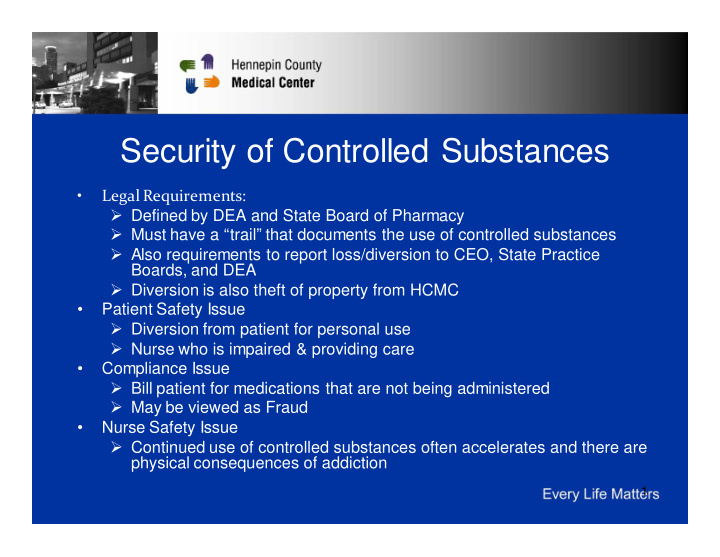



Security of Controlled Substances • Legal Requirements: Defined by DEA and State Board of Pharmacy Must have a “trail” that documents the use of controlled substances Also requirements to report loss/diversion to CEO, State Practice Boards, and DEA Diversion is also theft of property from HCMC • Patient Safety Issue Diversion from patient for personal use Nurse who is impaired & providing care • Compliance Issue Bill patient for medications that are not being administered May be viewed as Fraud • Nurse Safety Issue Continued use of controlled substances often accelerates and there are physical consequences of addiction 1
How big is this issue? • National Council of State Boards of Nursing estimate that 15% of healthcare professionals struggle with drug dependence sometime during their career • “If you aren’t finding diversion, its because you aren’t looking for it” Ohio State Code N Presentation 2
Access! • Nurses who perceive an availability, routinely give controlled substances, and perceive poor to non-existent workplace controls have double the odds of drug misuse. • Knowledge of drugs and easy availability promotes self medication • Nurses know the system and can avoid detection for a long time 3
Patterns of Behavior with Addiction/Diversion • May volunteer to work additional shifts • Significant overtime at the end of the shift • Come to work early • Go to the bathroom directly after withdrawing medication • Take extra long breaks • Work evening or night shift • Float pool staff or temporary agency • Defensive when questioned about patterns • Change in appearance • Deteriorating job performance 4
• Patients claim ineffective pain management when cared for by a particular nurse • Pattern of higher utilization than peers • Volunteer to help other nurses by administering pain medication • Use over ride function excessively • Batch waste controlled substances • Gap in time of documentation of administration 5
Tactics of diversion • Use of over ride function to obtain medications • Substitute saline for medication • Withdraw & chart as given but it is not • Create a discrepancy by withdrawing additional dose • Claiming breakage of syringe/vial • Claiming patient has refused a medication • Virtual waste where another nurse signs, but doesn’t actually witness waste 6
Prevention & Detection • Ensure that standards of practice are in place and staff are adhering to policy • Use the tools from Omnicell • Make certain that staff let you know if there is any discrepancy • Think about this issue in relationship to your staff • Contact Code N staff if there is any irregularity identified 7
Controlled Substances Policy Revised • Establish consistent practice on the unit: Order required for controlled substance If used during a procedure, RN must enter as a verbal order or ensure that there is an order Check prior administration Nurse who is to administer should withdraw the medication Exception during a procedure/emergency if another RN needs to get the medication Withdraw smallest possible dose from Omnicell Waste to ordered dose with another RN prior to administration Medication down a drain, syringe into black box Document the waste with another RN as soon as possible after administration 8
Consistent Practice Continued Chart administration of medication as soon as possible Medical record must reflect all doses of controlled substances that have been administered If administered during a procedure, may chart that it was administered by another RN or MD, indicating who gave it Discrepancies are important and must be resolved before the end of the shift Discharge medication is logged in and out of the CDAR. The CDAR is counted each shift 9
Review of Reports • Daily Review of report of over rides and high use reports – Take 15 minutes and compare the over rides to what is ordered and charted – Look at the high use and compare one shift to the next, look at the progress notes. – Monthly report of utilization report by each nurse • Thorough evaluation of any nurse who has an administration pattern that is 3+ standard deviations from the pattern on the unit 10
What to do if there is an Irregularity in use of Controlled Substances • An irregularity is: – Discrepancy that is not resolved – Nurse who has a pattern of high utilization > 3 standard deviations from unit pattern – Loss of a filled discharge prescription for controlled substances – Loss of a prescription for controlled substances – Report of a concern from a coworker or physician – Pharmacy report of an issue 11
Code N Team • The Code N Team is modeled after a team at Ohio State that responds to any irregularity in controlled substances • Chaired by Director of Pharmacy & Patient Care Director. Other members include Risk Management, Security, Investigations, Human Resources, Compliance • Assists with determining what investigation is appropriate & helps to coordinate that investigation • If you find an irregularity with use of controlled substances, page either Director. The group will meet with you that day & assist with the investigation • This is a patient and staff safety issue, so immediate attention is required. 12
Possible Parts of an Investigation • Controlled substance use report for individual nurse • Compare to medical record by patient – Review order – Withdrawal, administration, and waste for each dose – Review pain rating & any other documentation – Compare to medications received on previous and subsequent shifts – Print a copy of each piece of the medical record 13
Additional Investigation • Video from the medication room • Key card access to medication room • Tube station activity (for discharge medications) • Interview of patients about pain medication and relief of pain • Possible interview of unit staff 14
Recommend
More recommend